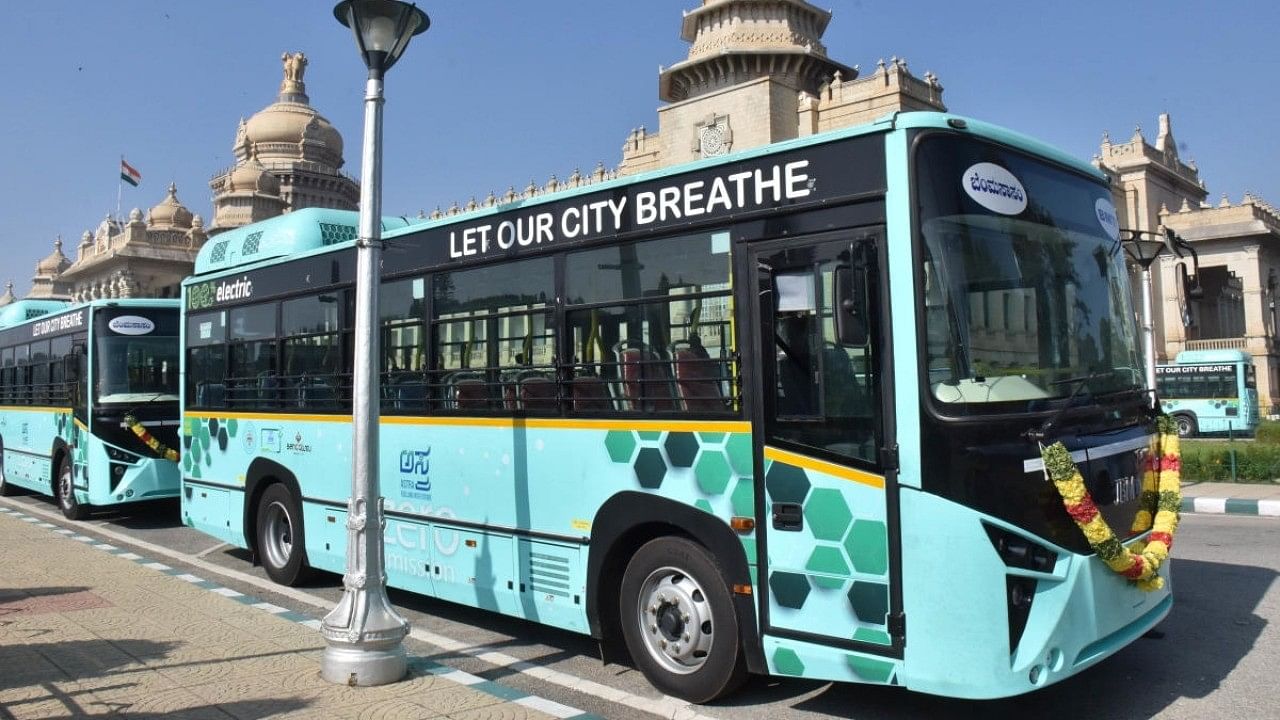
BMTC's e-buses.
Credit: DH File/B K Janardhan
Recently the Union government announced 10,000 electric buses to be deployed across 169 cities as part of the e-sewa scheme. It is aimed at modernising India’s public transportation system. Under the scheme, states/cities shall be responsible for running the bus services, and paying the bus operators while the government would assure support.
A closer examination reveals that this approach may not fully address the core issues at hand. There is an inadequate bus fleet strength both in the urban and rural areas across India. The State Transport Undertakings (STUs) are burdened by crippling debt across all states. The transportation needs of the nation require a more holistic solution entailing operational aspects, regulatory reforms, and the creation of an inclusive and efficient public transportation ecosystem. Moreover, India requires lakhs of more buses to meet the demands.
Under the Jawaharlal Nehru National Urban Renewal Mission (JNNURM) by the Ministry of Urban and Housing over 15,000 buses were sanctioned to the cities across India. This ushered in a new era of bus transport across the cities. These buses were entrusted either with the city municipal corporation- special purpose vehicles (city-SPVs) or with the STUs. However, the subsequent years revealed that bus operations, management, and maintenance are professionally demanding, and that the STUs lacked the required capacity and capability. These deficiencies were compounded by challenges such as route rationalisation, ridership data management, lack or inefficient approach of command and control mechanisms for monitoring the operations, and exposed the sub-optimal management of operations. The proposed e-seva scheme also falls back on this failed institutional mechanism.
Additionally, many state governments have nationalised their transport routes which has consolidated the STUs’ authority over operations. Thus, a majority of India’s transportation infrastructure and routes are placed squarely under the government’s control. For private bus operators this translates to issues with permits and capping fares by the state road transport authorities, stifling both competition and innovation.
The Motor Vehicle Act (MV Act) requires operators to obtain permits from the regional transport office (RTO) to ply their vehicles in specific routes. The State uses these provisions of the MV Act to quell any competition to save the STUs — this at the cost of public interest.
There is a larger interest in procuring the electric bus fleet at the state or city level. As in the past, the procurement is limited to the STUs or the city-SPV. The ticket fares, route permits, and safety norms are designed in a way to safeguard the state operators. Stage carriage or contract carriage permits are mostly dictated by the inherent bias towards the state operators. The issuing and signing off authorities are government secretaries and the RTOs, who are usually biased towards the state operators. Additionally, there is often a conflict of interest. For instance, the decision makers hold positions within the management of STUs and SPVs, such as the case of Kerala. .
In such a scenario, a private operator willing to provide premium quality services runs into trouble in procuring permits owing to government control over routes and fares. The resultant unavailability prevents the scope of introducing any quality services, depriving commuters of significant benefits.
India’s public transport system lacks efficiency, finance, and professionalism. Even the discourse around buying electric buses is not well-informed or debated. As cities and hinterlands lack public transport, the priority should be to ensure mobility provisions, rather than choice of fuel. This information asymmetry is due to the lack of market involvement and transparency in the processes, and a top-down decision-making approach. The manufacturers of the buses and the feeders are in a highly regulated market, so their R&D, and innovation are strangulated by the decision-makers at transport departments.
Urban and rural public transport lack adequate infrastructure such as bus stops, bus stations, and depots as they are in the hands of the state transport departments. Often, the capital investments are made without an informed understanding of the local needs, leading to ineffective spending and fragmented solutions. They lack the ecosystem assessments and end up spending money in silos without benefiting the stakeholders. Here, the private investments hold the potential to bring a change into the overall landscape in transport-related infrastructures.
Even the idea of providing Intelligent Transport System — an advanced framework that improves the management and operation of transportation systems via real-time data, sensors, communication networks, and advanced analytics — is blocked by the state transport departments which are oblivious to information and market competition and are biased towards state operators. In most states the public transport sector has remained the same except for the occasional addition of buses. The sector must be liberalised and subject to market mechanisms.
To meet the rising commuting demands, increasing the supply of buses through a market-based approach is key. Yet, as important as competition is in addressing the commuter's needs and preferences, it is acknowledged that the markets will not necessarily always deliver the best outcomes for consumers, private operators, or the government.
To address this, an independent regulatory board should be established to set a legal, operational, and institutional framework so that the public and private players have a level playing field. An entity with regulatory independence can act objectively and impartially to ensure effective and efficient public services. It can ensure equity, competition, and transparency in information. It is time we did away with the transport secretary, transport commissioner and the RTO mechanism to manage and decide on the operative part of public transport.
(D Dhanuraj is Chairman, and Nissy Solomon is Honorary Trustee (Research & Programs), Centre for Public Policy Research, Kochi.)
Disclaimer: The views expressed above are the author's own. They do not necessarily reflect the views of DH.